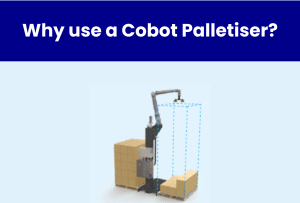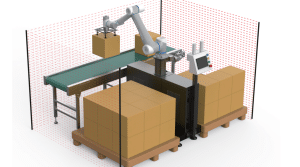The move from industrial robots to a cobot palletiser has proven to be transformative for SME manufacturers
Manufacturing factories typically palletise their product as their final production step and industrial robot palletisers have traditionally been the preferred solution for big-volume manufacturing. SME manufacturers now have a possible alternative to traditional automation systems with a collaborative robot or “cobot” palletiser. Cobots are designed to meet many SME-specific requirements. Our latest Knowledge Base post identifies key differences between cobot palletisers and industrial robot palletisers to show why cobots might be the better choice for SMEs.
Understanding Industrial Robot Palletisers
Because of their ability to process products at high speeds, industrial robot palletisers have served as the standard solution for palletising in large-scale manufacturing operations. These systems exist to process many identical items at high speed with efficiency. Their fast operation and heavy load capacity require large areas of factory floor space to be completely enclosed with protective guarding for personnel safety. The trade-off between speed, space, and safety presents no problem for most large-scale manufacturers. However, these systems have limited ability to accommodate product variations while incurring high costs for rework whenever production requirements change.
What are Cobot Palletisers?
Cobots are robots which can perform tasks safely either together or in close proximity to operators. When used appropriately within a solution’s risk assessment, cobots can often operate without heavy safety guarding. Cobot palletisers operate at reduced speed and with reduced weight capacity to lower the risk of injury during hazard assessment procedures. Their adaptability and user-friendly nature make them suitable for applications where production needs often differ. Due to their compact nature , these machines take up less floor space, and many have a portable design that enables movement to multiple operational areas. SMEs benefit substantially from this versatility since they typically need to produce multiple product lines and packaging arrangements through existing equipment without spending on new machinery.
Advantages of Cobots for SME Manufacturers
Small Footprint:
Many SME factories have grown within their facilities until they are bursting at the seams.. A Cobot Palletiser stands out for SMEs because it uses minimal floor space. Manufacturers can integrate cobots into their current workspace with little renovation due to their compact nature.
Less Guarding:
The safety features of cobots enable them to operate alongside humans as their reduced speed and lighter capacity eliminate the need for extensive guarding found with traditional industrial robot solutions. The simpler guarding requirements lead to faster installation times and reduced maintenance expenses while creating a safer environment for human workers to move freely around the machine.
Mobility:
A significant number of cobot palletisers offer high versatility because they can be moved easily to serve different production locations on the plant floor. SMEs find great value in the mobility and flexibility of cobots because they often don’t run every production line at once and instead run different production lines depending on the shift, the day, or the week.
Flexibility of Boxes:
Small and medium-sized enterprises face more box size and packaging complexity in their operations than larger volume producers do. Cobot palletisers have been designed to accommodate numerous product variations and enable efficient product changes between different items.
Throughput requirements:
High-volume factories like those operated by Coca-Cola and Pfizer deploy industrial robot palletisers because these machines are the only way to deliver the required production rates. The system reaches peak efficiency through rapid product movements and combining items into weight-maximising lifts, however, the needs of SME factories are different from those of the large-scale factories. A cobot offers similar or improved performance over human palletising workers, so these workers can be moved to more interesting, safer and less monotonous tasks.
Who is a good fit for a Cobot Palletiser?
Manufacturers do not always need the high-speed and high-payload functions of industrial robots. A cobot palletiser represents your best option if you experience these operational issues:
- Tight workspace – SMEs are used to getting the most out of their factories and utilising every square inch. Packing lines are often used for a variety of products and the lines may be quite close together so the workforce can supervise multiple processes at once. The small footprint and the option of working without guarding open up the possibility of fitting a robot palletiser into an SME factory.
- Manual palletising – Many SME factories are currently manually stacking their products on pallets. This work is tedious, strenuous and monotonous. Lifting is the number two cause of workplace injuries. (https://www.jmw.co.uk/services-for-you/personal-injury/blog/why-do-workplace-injuries-occur-5-most-common-causes-workplace-accidents) Often, there are more interesting and rewarding tasks which need to be completed. The size of the boxes and the speed at which a human can complete the palletising requirements are well-suited for a cobot palletiser.
- Multiple box sizes using the same line – If your factory runs many different products on the same packing and palletising line, then a cobot palletiser could be a good fit.
Industrial robot palletisers are designed for maximum speed and efficiency, which can make them less adaptable to product variations. Also, if the breadth of product variation is known during development, then Cobot palletisers can be designed to be suitable for a wide variety of box sizes. Also, because of the ease of programming, if a new product or a short-term product needs to be programmed and palletised, as long as it fits inside the original design envelope, the factory could be up and running in a few hours.
Choose the right solution for you
If you are closer to a craft brewer than to a Carlsberg factory, a cobot palletiser might be the right solution for you. They are a practical and efficient alternative to traditional industrial robot palletisers where the volumes don’t justify the investment. Their smaller footprint, reduced guarding requirements, and flexibility make them well-suited to environments where manual palletising is still being used, space is tight, and production demands are varied. Unlike large-scale manufacturers that prioritise speed and high-volume throughput, SMEs benefit from enhanced worker safety, improved consistency, and adaptable programming. As SMEs look for ways to increase capacity with minimal capital investment, cobot palletisers offer a fantastic solution to keep them competitive.
Start your Cobot Palletiser Journey
As the first step to introducing cobot palletisers to your factory floor, you can learn more about our own palletising cobot product range or drop us a line.





